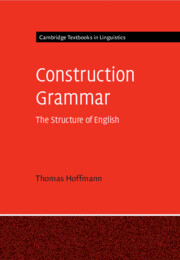Refine search
Actions for selected content:
6584 results in Grammar and Syntax
17 - Philological Approaches
- from Part IV - Empirical Approaches
-
-
- Book:
- The Cambridge Handbook of Historical Orthography
- Published online:
- 28 September 2023
- Print publication:
- 12 October 2023, pp 338-359
-
- Chapter
- Export citation
3 - Elements of Writing Systems
- from Part II - Structures and Theories
-
-
- Book:
- The Cambridge Handbook of Historical Orthography
- Published online:
- 28 September 2023
- Print publication:
- 12 October 2023, pp 50-73
-
- Chapter
- Export citation
15 - Materiality of Writing
- from Part IV - Empirical Approaches
-
-
- Book:
- The Cambridge Handbook of Historical Orthography
- Published online:
- 28 September 2023
- Print publication:
- 12 October 2023, pp 305-323
-
- Chapter
- Export citation
5 - Theoretical Approaches to Understanding Writing Systems
- from Part II - Structures and Theories
-
-
- Book:
- The Cambridge Handbook of Historical Orthography
- Published online:
- 28 September 2023
- Print publication:
- 12 October 2023, pp 95-117
-
- Chapter
- Export citation
29 - Discourse and Sociopolitical Issues
- from Part V - Explanatory Discussions
-
-
- Book:
- The Cambridge Handbook of Historical Orthography
- Published online:
- 28 September 2023
- Print publication:
- 12 October 2023, pp 578-595
-
- Chapter
- Export citation
26 - Sociolinguistic Variables in English Orthography
- from Part V - Explanatory Discussions
-
-
- Book:
- The Cambridge Handbook of Historical Orthography
- Published online:
- 28 September 2023
- Print publication:
- 12 October 2023, pp 520-536
-
- Chapter
- Export citation
Part II - Structures and Theories
-
- Book:
- The Cambridge Handbook of Historical Orthography
- Published online:
- 28 September 2023
- Print publication:
- 12 October 2023, pp 27-160
-
- Chapter
- Export citation
Contributors
-
- Book:
- The Cambridge Handbook of Historical Orthography
- Published online:
- 28 September 2023
- Print publication:
- 12 October 2023, pp xiii-xxii
-
- Chapter
- Export citation
22 - Orthographic Norms and Authorities
- from Part V - Explanatory Discussions
-
-
- Book:
- The Cambridge Handbook of Historical Orthography
- Published online:
- 28 September 2023
- Print publication:
- 12 October 2023, pp 436-456
-
- Chapter
- Export citation
1 - Historical Orthography: Purposes, Ambitions and Boundaries
- from Part I - Introduction
-
-
- Book:
- The Cambridge Handbook of Historical Orthography
- Published online:
- 28 September 2023
- Print publication:
- 12 October 2023, pp 3-26
-
- Chapter
- Export citation
13 - What Is Spelling Standardization?
- from Part III - Organization and Development
-
-
- Book:
- The Cambridge Handbook of Historical Orthography
- Published online:
- 28 September 2023
- Print publication:
- 12 October 2023, pp 265-282
-
- Chapter
- Export citation
2 - Classifying and Comparing Early Writing Systems
- from Part II - Structures and Theories
-
-
- Book:
- The Cambridge Handbook of Historical Orthography
- Published online:
- 28 September 2023
- Print publication:
- 12 October 2023, pp 29-49
-
- Chapter
- Export citation
Name Index
-
- Book:
- The Cambridge Handbook of Historical Orthography
- Published online:
- 28 September 2023
- Print publication:
- 12 October 2023, pp 789-800
-
- Chapter
- Export citation
Part V - Explanatory Discussions
-
- Book:
- The Cambridge Handbook of Historical Orthography
- Published online:
- 28 September 2023
- Print publication:
- 12 October 2023, pp 417-643
-
- Chapter
- Export citation
7 - Typologies of Writing Systems
- from Part II - Structures and Theories
-
-
- Book:
- The Cambridge Handbook of Historical Orthography
- Published online:
- 28 September 2023
- Print publication:
- 12 October 2023, pp 138-160
-
- Chapter
- Export citation
Subject Index
-
- Book:
- The Cambridge Handbook of Historical Orthography
- Published online:
- 28 September 2023
- Print publication:
- 12 October 2023, pp 801-812
-
- Chapter
- Export citation
16 - Data Collection and Interpretation
- from Part IV - Empirical Approaches
-
-
- Book:
- The Cambridge Handbook of Historical Orthography
- Published online:
- 28 September 2023
- Print publication:
- 12 October 2023, pp 324-337
-
- Chapter
- Export citation
Figures
-
- Book:
- The Cambridge Handbook of Historical Orthography
- Published online:
- 28 September 2023
- Print publication:
- 12 October 2023, pp ix-x
-
- Chapter
- Export citation

The Cambridge Handbook of Historical Orthography
-
- Published online:
- 28 September 2023
- Print publication:
- 12 October 2023

Construction Grammar
-
- Published online:
- 20 September 2023
- Print publication:
- 28 July 2022
-
- Textbook
- Export citation
